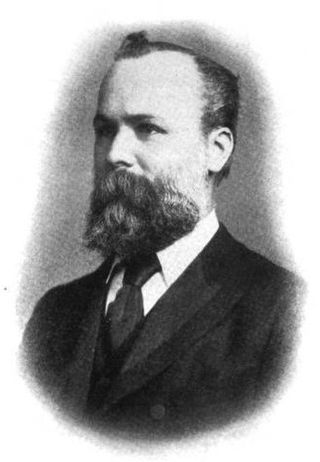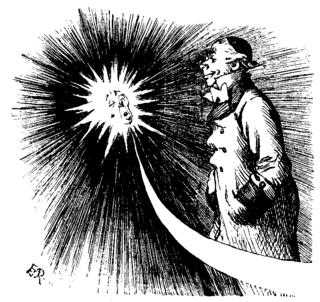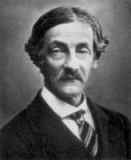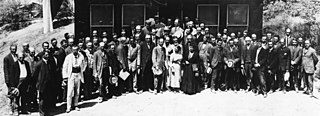
Sir Frank Watson Dyson, KBE, FRS, FRSE was an English astronomer and the ninth Astronomer Royal who is remembered today largely for introducing time signals ("pips") from Greenwich, England, and for the role he played in proving Einstein's theory of general relativity.

Edward Walter Maunder was an English astronomer. His study of sunspots and the solar magnetic cycle led to his identification of the period from 1645 to 1715 that is now known as the Maunder Minimum.

Andrew Claude de la Cherois Crommelin was an astronomer of French and Huguenot descent who was born in Cushendun, County Antrim, Ireland. He was educated in England at Marlborough College and Trinity College, Cambridge. After a spell teaching at Lancing College he found permanent employment at the Royal Greenwich Observatory in 1891. He joined the Royal Astronomical Society in 1888 and was its president from 1929-1931. In 1895 he joined the British Astronomical Association and was president from 1904-1906 and directed its comet section 1898-1901 and 1907-1938.

William Frederick Denning was a British amateur astronomer who achieved considerable success without formal scientific training. He is known for his catalogues of meteor radiants, observations of Jupiter's red spot, and for the discovery of five comets. Outside astronomy, as a young man, Denning showed prowess at cricket to the extent W G Grace invited him to play for Gloucestershire. However Denning's retiring nature made him decline the offer.

A transit of Mercury across the Sun takes place when the planet Mercury passes directly between the Sun and a superior planet. During a transit, Mercury appears as a tiny black dot moving across the Sun as the planet obscures a small portion of the solar disk. Because of orbital alignments, transits viewed from Earth occur in May or November. The last four such transits occurred on May 7, 2003; November 8, 2006; May 9, 2016; and November 11, 2019. The next will occur on November 13, 2032. A typical transit lasts several hours. Mercury transits are much more frequent than transits of Venus, with about 13 or 14 per century, primarily because Mercury is closer to the Sun and orbits it more rapidly.
Leslie John Comrie FRS was an astronomer and a pioneer in mechanical computation.

Alexander Stewart Herschel, DCL, FRS was a British astronomer.

Nathaniel Everett Green FRAS was an English painter, art teacher and astronomer. He professionally painted landscapes and portraits, and also gained fame with his drawings of planets.
William Sadler Franks was a British astronomer.

Mary Adela Blagg was an English astronomer and was elected a fellow of the Royal Astronomical Society in 1916.

Annie Scott Dill Maunder was an Irish-British astronomer, who recorded the first evidence of the movement of sunspot emergence from the poles toward the equator over the Sun's 11-year cycle. She was one of the leading astronomers of her time, but because of her gender, her contribution was often underplayed at the time. In 1916 she was elected to the Royal Astronomical Society, 21 years after being refused membership because of her gender.
Reverend John Mackenzie Bacon, FRAS was an English astronomer, aeronaut, and lecturer.
Arthur Robert Hinks, CBE, FRS was a British astronomer and geographer.
Mary Acworth Evershed was a British astronomer and scholar. Her work on Dante Alighieri was written under the pen name M.A. Orr.

Alice Everett was a British astronomer and engineer who grew up in Belfast. Everett is best known for being the first woman to be paid for astronomical work at the Royal Observatory, Greenwich, when she began her employment at the observatory January 1890. In 1903 she was the first woman to have a paper published by the Physical Society of London. She also contributed to the fields of optics and early television.
Reginald Lawson Waterfield was a British hematologist known for his work in amateur astronomy, specialising in astrometry and the photography of comets. He was elected to the British Astronomical Association on 25 November 1914 and to the Royal Astronomical Society on 10 November 1916. Both elections being at the proposal of W H Steavenson. Waterfield served as Director of the British Astronomical Association Mars Section from 1931 to 1942 and its president from 1954 to 1956. For his work in astronomy he won the 1942 Jackson-Gwilt Medal. After World War II he had to use a wheelchair due to polio. The minor planet 1645 Waterfield is named jointly for him and his cousin William Francis Herschel Waterfield (1886-1933), who was also a member of the British Astronomical Association and Fellow of the Royal Astronomical Society.
Alice Grace Cook (18 February 1877 - 27 May 1958), known as Grace Cook or A. Grace Cook was a British astronomer. Cook lived in Stowmarket, Suffolk. After she died she was remembered by her colleagues as a skilled and dedicated observer. In September 2021 it was announced that a new school in the town was to be named after Grace Cook. The school will be run by the Orwell Multi Academy Trust. In March 2023 minor planet 2000 EY156 was named Gracecook in her honour.
Charles Thomas Whitmell was an English astronomer, mathematician and educationalist.

Aloysius Laurence Cortie was an English Jesuit astronomer. He served as director of the Stonyhurst College Observatory and contributed to the study of the Sun, including through observing solar eclipses.
George Frederick Chambers was an English barrister, amateur astronomer and author, who wrote a number of popular books about science.











